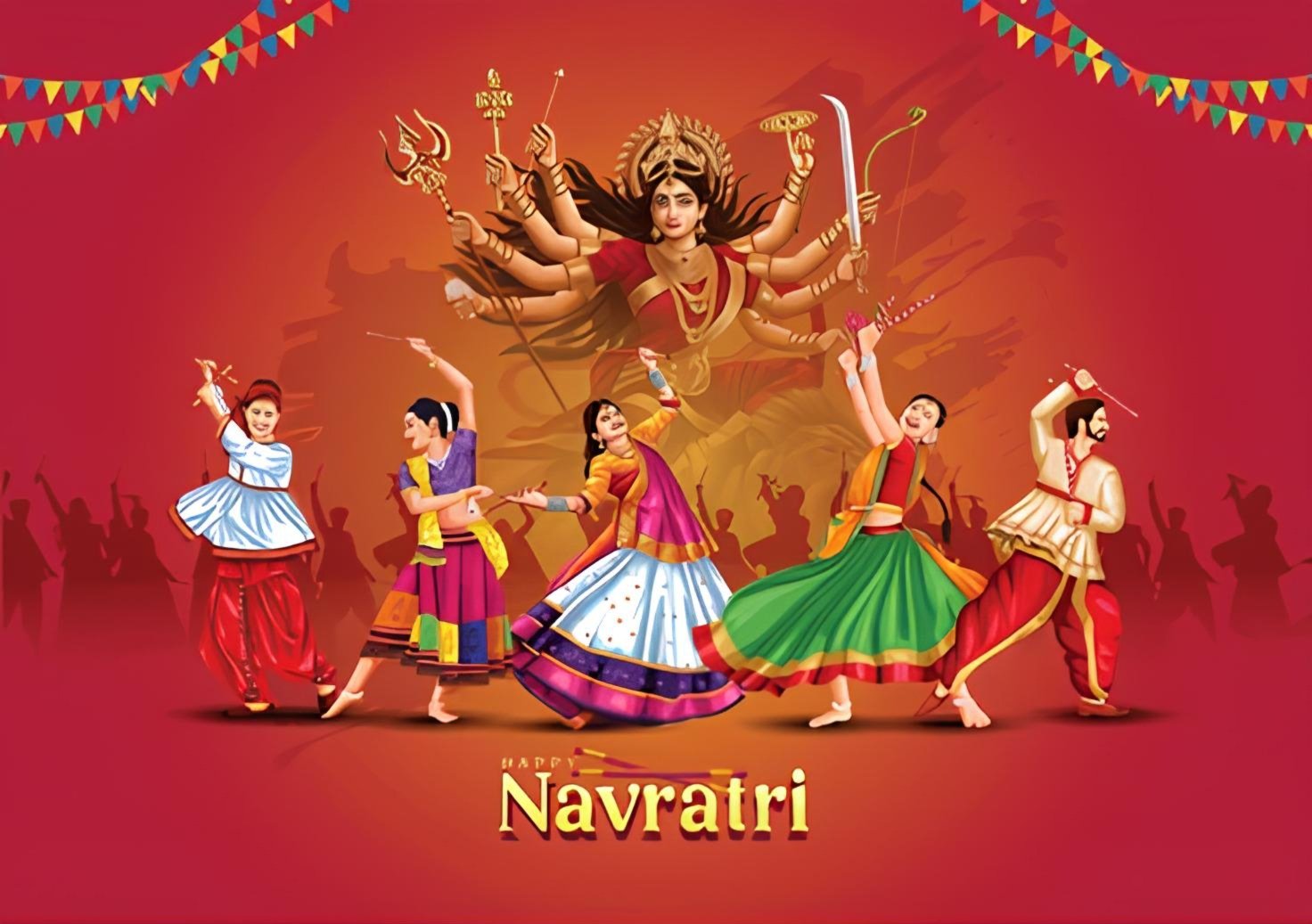Navratri 2024 is a nine-day Hindu festival that honours the triumph of good over evil. It stands as one of the most significant celebrations in Hinduism, observed by devotees around the globe. Each of the nine days is dedicated to a different form of the goddess Durga.

Day 1: Shailputri – The first form of Goddess Durga is Shailaputri. At the pinnacle of every experience, we find the Mother Divine. “Shaila” signifies the peak, representing something extraordinary that strives to reach new heights. She embodies the energy of the mountains—solid yet emanating subtle, invisible waves. Shailaputri symbolises the delicate energy from which the entire universe emerges. Whenever we feel spiritually attuned, this consciousness manifests as Shailaputri.
Day 2: Brahmacharini – The second name of the Mother Divine is Brahmacharini. “Brahma” signifies infinity—an essence that moves within the infinite. You might question the purpose of movement within infinity. If it encompasses everything, where can it go? The answer is both yes and no. While it is all-encompassing, it remains dynamic. If we perceive infinity as static, we overlook a subtle truth. Movement within infinity captures the essence of the subtle, much like space, which appears still yet is filled with immense activity. Consider the ocean, which remains in place while continuously shifting through its waves. Even within its vastness, waves emerge. Thus, one interpretation of Brahmacharini is movement within infinity, while another reflects the pure, untouched aspect of energy. Like the sun’s rays—ancient yet perpetually fresh and new. This sense of renewal is embodied in the second form of Durga.
Day 3: Chandraghanta – The third form of the Mother Divine is Chandraghanta. Chandra refers to the moon, symbolising the mind and that which captivates it. She embodies beauty itself. Whenever you perceive beauty, it is due to the energy of the Mother Divine present there. Without her energy, nothing can truly be beautiful. No matter how attractive a face may be, if it lacks life, we do not consider it beautiful. We do not find beauty in a lifeless body because it lacks energy. It is this energy that infuses beauty into both humans and animals.
Day 4: Kushmanda – The fourth form of the Mother Divine is known as Kushmanda. There are 440 Milky Ways and billions of suns. The consciousness that underlies all creation, which has also manifested as creation, is Kushmanda. This is the prana energy, the consciousness that connects the tiniest microcosm to the expansive macrocosmic universe—formless yet giving rise to all imaginable forms. She represents a sphere of energy. Whenever you sense a sphere of energy or prana, recognize that this is one aspect of Durga or the Mother Divine. Interestingly, a pumpkin is also referred to as Kushmanda because it is a source of immense energy or prana shakti, possessing the highest prana among all vegetables.
Day 5: Skanda Mata – The fifth form of the Mother Divine is Skandamata. While every mother embodies the essence of protection, Skanda Mata, the mother of the protector, combines compassion, affection, and a sense of pride. She represents that aspect of Durga which offers protection to the entire universe and resides within our consciousness. She is also the mother of the six systems of knowledge, known as the shad-darshanas: Nyaya, Vaisheshika, Sankhya, Yoga, Vedanta, and Uttara Mimamsa. Additionally, there are the shad-angas, or six limbs of knowledge, including Jyotish, music, phonetics, and various other disciplines. Skandamata is the mother of all this wisdom.
Day 6: Katyayani – The sixth form of the Mother Divine is Katyayani. She embodies the energy that arises from the seer aspect of consciousness. The term Katyayan means seer—when you become a witness to your own existence. When you realize, “I am neither the body nor the mind,” and delve deep within, you become the observer of everything around you. From this state of awareness, energy flows, bringing with it the power of intuition. This intuitive ability is something we often see in our children. This is the essence of Katyayani—seeing beyond the senses and knowing beyond logic. That energy is Katyayani.
Day 7: Kalratri – The seventh form of Shakti is Kaalaratri. She embodies the profound, dark energy—a dark matter that contains infinite universes and offers solace to every soul. When you feel joy or tranquillity, it is the blessing of Ratri—the night. Why is night referred to as Ratri? Because night provides comfort to all living beings. Regardless of what occurs during the day, when you sleep, you find inner peace and rest. Kaalaratri represents that aspect of the Mother Divine that exists beyond the universe, yet brings comfort to every heart and soul
Day 8: Maha Gauri – The eighth form of the Mother Divine is Mahagauri. She embodies beauty, grace, and the force that drives you toward ultimate freedom and liberation. Gauri signifies that which grants knowledge, brings movement to life, and liberates you. Mahagauri is the epitome of purity and fairness. We refer to her as Gauri, as fairness symbolises this name. However, on a deeper level, ‘Gau’ represents knowledge, progress, achievement, and liberation. Gauri is the one who bestows wisdom, propels us forward in life, fulfils our needs, and ultimately leads us to Moksha. This Gauri principle is the source of happiness, guiding us on the path to liberation.
Day 9: Siddhidatri – The ninth form of Devi Shakti is Siddhidatri. She embodies the blessings of the Mother Divine and brings miracles into our lives. What seems impossible becomes possible through her grace. She encourages us to think beyond our limitations, to rise above the logical mind, and to see beyond the confines of time and space. Siddhidatri is the one who bestows the rewards of our efforts. While we may put in the hard work, the results are not solely in our control; they lie in the hands of the Mother Divine—only through her grace do our efforts yield results. From the spiritual heights of Shailputri to the wonders of Siddhidhatri, these forms guide us to connect with their divine attributes. As we meditate on each aspect, may we welcome their transformative energy, enriching our lives and deepening our bond with the universal essence of Shakti.
Each day of Navratri carries its own unique significance and rituals.
Here are some of the most common Navratri traditions:
- Fasting: Many Hindus observe fasting during Navratri, typically consuming just one meal each day.
- Puja: Each day of Navratri, Hindus engage in puja, or worship, dedicated to the goddess Durga.
- Garba and Dandiya Raas: Traditional dances known as Garba and Dandiya Raas are performed throughout Navratri.
- Kanya Pujan: On the eighth day of Navratri, nine young girls are honoured as representations of the goddess Durga.
Navratri is a significant time for Hindus to celebrate their faith and cultural heritage. It also serves as an opportunity for families and friends to gather and enjoy each other’s presence.
Here are some additional facts about Navratri 2024
- Navratri is also referred to as Durga Puja.
- It is celebrated in the Hindu month of Ashwin.
- The dates for Navratri change each year.
- Navratri is recognized as a national holiday in India.
Additionally, Navratri is a period for reflection and personal growth. Hindus are encouraged to take this time to concentrate on their goals and aspirations.
I hope this blog has provided you with a clearer understanding of Navratri. If you have any questions, please feel free to leave a comment below.
Wishing you a joyful Navratri!





